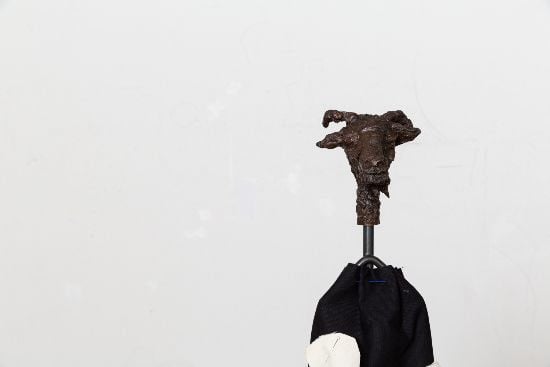Sally Smart – The Artists Family

Mostra personale.
Comunicato stampa
PostmastersROMA is extremely pleased to present Sally Smart's second solo exhibition with the gallery in Rome and her sixth under the Postmasters Gallery umbrella.
The show, The Artists Family, dances with mythology, archetypes, psychology, art, theatre and the entangled relationships between the body, history and culture. Layered and entangled, these motifs come together in the multi-material sculptures and wall works.
Sally Smart is well known for her installations, performances and textile artworks. For our exhibition in Rome, Smart has created her own performance troupe in a form of bronze/textile sculptures and embroideries that inhabit the gallery space. The show encapsulates various points in the history of theatre, dance and performance, starting from the ancient Roman/Greek tragedy, 16th century Commedia Dell’Arte and the early 20th century Ballets Russe.
The embroideries on view are reconfigured, fragmented, and abstracted parts of the costumes of the Ballets Russes which were originally designed by Picasso, de Chirico, Delaunay, Goncharova, Larionov, and Matisse among others.
Smart's restructured textiles adorn the sculptures in the exhibition. Their heads, made out of bronze, are archetypal and mythological personages. Mother, Artist, Harlequin, Flora, Goat, Pulcinella make their contemporary appearance in The Artists Family.
The sculptures are a place of connecting and layering of materials and meanings. The costumes have their own significance, and here they shed their primary function and become an integral part of the sculpture’s subject, made in bronze. For example, The Goat's textile is based on the Faun character’s costume designed by Léon Bakst, for the Ballets Russes The Afternoon of a Faun, which was choreographed by Vaslav Nijinsky. Flora, is a Roman goddess of flowers and spring. Daphne, is a re-imagination of a part of Bernini’s sculpture at the Galleria Borghese.
The larger scaled wall works also relate to Italy and Rome in particular. The brick motifs, come from ancient Roman walls and the sets of the Ballets Russes. The diamond shapes refer to the floor mosaic in Villa Massimo in Rome along with the legacies of the Commedia dell’ Arte and the Harlequin character. Pulcinella, Goat, and Daughter Architect all have connections to these performance histories as well.
Furthermore, Italy was important in the history of the Ballets Russes with several great collaborations initiating in Rome. Picasso met his wife Olga Khokhlova, dancer for the Ballet Russe, in Rome. Sergei Diaghilev and Picasso, all worked on the ballet Parade in Rome. Pulcinella was the ballet Picasso was most proud of, and it all came from his visit with Stravinsky to Pompei where they were first introduced to the Commedia Dell’Arte characters. De Chirico worked on the last ballet of Diaghilev for the Ballets Russe, Le Bal. It’s set design and costumes included broken fragments of classical ancient Roman architecture, which are integrated into Sally Smart’s practice as well.



